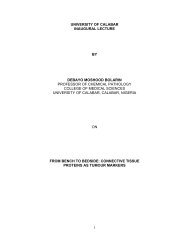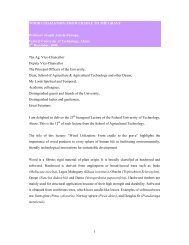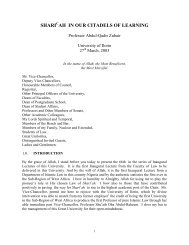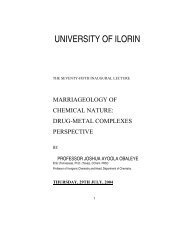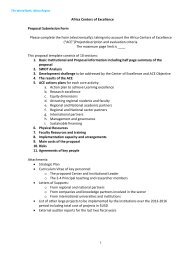relevant micro-concepts of common nigerian civil engineering
relevant micro-concepts of common nigerian civil engineering
relevant micro-concepts of common nigerian civil engineering
You also want an ePaper? Increase the reach of your titles
YUMPU automatically turns print PDFs into web optimized ePapers that Google loves.
2.4 Hydraulic works: include harbours, canals, barrages, spillways, flood control, sea defence,<strong>civil</strong> works associated with hydro-electric power, pumping stations, irrigation, aqueducts,pipelines, water supply and treatment, main drainage and sewage treatment. Even though thecentral theme in hydraulic works is the beneficial harnessing <strong>of</strong> the properties <strong>of</strong> water formankind, nonetheless many <strong>of</strong> the associated structures required are very huge <strong>engineering</strong>edifices <strong>of</strong> soil, rock, concrete and steel. Jetties, Terminals and deep water ports are verycomplex hydraulic structures to construct: the Rotterdam, as example, is the world’s largest port(by length <strong>of</strong> quay or berth in the port). There are also canals and Inland Navigations, thenotable ones being St. Lawrence Seaway, Europe canal, Grand Canal, Amazon, Mississippi,Suez, Panama, etc. In Nigeria, dredging has been undertaken for inland navigation on the Niger,Imo and Cross Rivers. Flood control and sea defences are great schemes for protection againstriver floods and tidal waves. Their main material is sand/soil and rock boulders as well as sheetpiles <strong>of</strong> steel or gravity walls <strong>of</strong> masonry. Pipelines can be <strong>of</strong> asbestos-cement, galvanized ironand plastic: recently, some Nigerians have been writing on bamboo soil pipes.3.0 MICROCONCEPTS OF SOIL AS FOUNDATION AND CONSTRUCTIONMATERIALFrom the account <strong>of</strong> structures presented above, it is clear at this stage that one <strong>of</strong> the versatile<strong>civil</strong> <strong>engineering</strong> materials is the soil. Later on, when I shall be listing an account <strong>of</strong> my personalcontributions in research and practice, it would then be observed that Nigerian soils exist inmany varieties exhibiting different properties and characteristics, some attractive and otherproblematic. Basically, in summary, soils are applied in practice as:i) Foundations <strong>of</strong> buildings and all forms <strong>of</strong> structures.ii) Construction material for road base, sub base and sub grade courses in roadways.iii) Construction material for the foundations <strong>of</strong> paved areas, parking spaces, airporttarmacs etc.iv) Construction material for earth dams, cut<strong>of</strong>f walls, central core <strong>of</strong> rock fill dams andcertain seepage and erosion control structures.v) Construction material for earth fills beneath the floors <strong>of</strong> structures.vi) Construction material for backfills behind retaining wall structures.8







